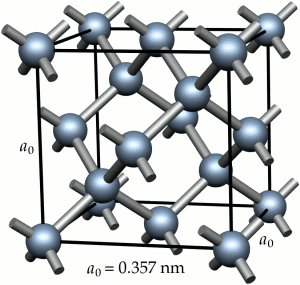Crystal Structure

The crystal structure of diamond is equivalent to a face-centred cubic (FCC) lattice, with a basis of two identical carbon atoms: one at (0, 0, 0) and the other at (1/4, 1/4, 1/4), where the coordinates are given as fractions along the cube sides. This is the same as two interpenetrating FCC lattices, offset from one another along a body diagonal by one-quarter of its length.
The conventional unit cell is cubic (see diagram), with a side length a0 approximately equal to 3.567 Å (0.3567 nm) at room temperature. From this we can derive a few other quantities:
The C–C bond length d is equal to 1/4 of the cubic body diagonal, so that d = (√3)a0/4 ≈ 1.54 Å. The conventional cell contains the equivalent of 8 whole C atoms. The atomic density is therefore given by 8/(a03) ≈ 8/((3.567×10-10 m)3) ≈ 1.76×1029 atoms/m3 (1.76×1023 atoms/cm3).
Each atom can be thought of as a sphere with a radius of 1/8 of the cubic body diagonal. The packing fraction is therefore [8×(4/3)π((√3)a0/8)3]/[a03], which simplifies to (√3)π/16 ≈ 0.34.
References
The content on this page is adapted from that found in my Ph.D. thesis.